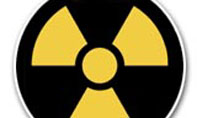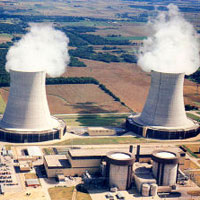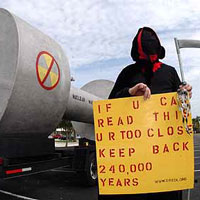- About Us
- Columns
- Letters
- Cartoons
- The Udder Limits
- Archives
- Ezy Reading Archive
- 2024 Cud Archives
- 2023 Cud Archives
- 2022 Cud Archives
- 2021 Cud Archives
- 2020 Cud Archives
- 2015-2019
- 2010-2014
- 2004-2009
 |
Going nuclear |
Over the past 20 to 30 years a gradual awareness has built up concerning the impending environmental catastrophe resulting from greenhouse gas emissions.
Some scientists now predict that the earth has only 20 years to reverse the trend of increasing carbon emissions before irreversible damage is done. Given the urgency and intractability of this problem, it is astonishing to think that an energy source capable of producing large scale energy with zero carbon emissions is already available and in use. There are currently 440 nuclear reactors operating around the world. Despite this, Nuclear has been the dirty word of the energy debate for almost 20 years. In many countries the mere suggestion of expanding nuclear power would be political suicide.
 For most of the counter'culture generation all debate on nuclear energy ended on April 25 1986. There had been nuclear accidents before Chernobyl. For instance Three Mile Island has been attributed with a large portion of the blame for mistrust in nuclear energy in the US, but it was Chernobyl that sealed the lid. 31 dead and 135,000 evacuated. An area of 20 square miles just north of Kiev rendered uninhabitable for a very long time. Chernobyl is a deserted place frozen in communist time 'a stark symbol of the new risks of the nuclear age. The imprint on Russia and Europe will take decades to measure. Some estimate that the leaked radiation contributed to an additional 10,000 deaths in the years following.
For most of the counter'culture generation all debate on nuclear energy ended on April 25 1986. There had been nuclear accidents before Chernobyl. For instance Three Mile Island has been attributed with a large portion of the blame for mistrust in nuclear energy in the US, but it was Chernobyl that sealed the lid. 31 dead and 135,000 evacuated. An area of 20 square miles just north of Kiev rendered uninhabitable for a very long time. Chernobyl is a deserted place frozen in communist time 'a stark symbol of the new risks of the nuclear age. The imprint on Russia and Europe will take decades to measure. Some estimate that the leaked radiation contributed to an additional 10,000 deaths in the years following.
In light of this it may come as some surprise that the Bush administration has, since assuming power in 2001, placed nuclear energy back on the options table. A few quick facts will give you an idea why:
- Nuclear energy is more efficient than coal, gas, solar or wind (it costs about 2-4 cents per kilowatt' barely enough to meter)
- Just one ounce of enriched uranium produces the same amount of electricity as 4 tonnes of coal or 15 barrels of oil;
- Cheap electricity is perhaps the most reliable spur to economic growth imaginable this is because the proportion of total energy resources used by industrialised economies to generate electricity is about 40% and over 60% of GDP comes from industries that use electricity as their front'end fuel. Cheap energy equals more profits and jobs; and
- A cheap domestically produced energy alternative decreases reliance on the Arab oil states ' this translates to less military expenditure and fewer politically risky dictator mates.
But before we get carried away with the nuclear horizon we must, of course, take into account the environmental costs. Most objections to nuclear power fall into three categories, the safety of the process, the storage of waste and the threat of nuclear war. A few brief comments on each may be useful for understanding the issues.
Is nuclear energy safe to produce?
Nuclear fission produces enormous heat from very little fuel. This provides the steam for electricity while giving off harmful levels of radiation. To prevent the release of the radiation, a reactor is covered by a pressurised shield which looks a bit like a huge dome. The possibility of radiation leaks is the most common risk associated with the production of nuclear energy.
The size of a reactor is very small which makes it easy to 'overbuild' protective walls. At Three Mile Island, the fact that a large scale leak of radiation was prevented by this very system was somehow lost amongst the hysteria surrounding the meltdown. Chernobyl on the other hand was an RBMK reactor with a positive void co'efficient of radioactivity. In English this means that as the reactor got hotter, the rate of nuclear reaction increased. Chernobyl hit 150 times its normal power level before pressurised steam blew the plant apart (which did not have a containment shell). With today's reactors and the 11,000 reactor years of experience we have accumulated, the chance of a serious radiation leak like Chernobyl is extremely remote.
There should always be reservation, however, when considering the risk of nuclear accidents. It is simply not possible to operate a reactor without some risk of accidents occurring. Despite this, when compared to our other options, nuclear is the safest large scale energy source available. This statement may sit uncomfortably next to the numbers often associated with the Chernobyl disaster, but if the same formula were used for other power sources i.e. taking into account the full long term effect of pollutants, coal or gas power would be partly accountable for literally millions of deaths over the last 200 years. A study by the Paul'Scherrer Institute in Switzerland calculated the fatalities caused by each power source per terra-watt of electricity they produced. Between 1969 and 1996 coal power caused 342 deaths per terra'watt, gas power 85, hydro 884 and LPG a whopping 3,280. Nuclear accidents caused just 8 deaths per terra'watt. It is also reasonable to assume that as experience and expertise develops, this record will improve in a similar fashion to the safety record of coal mining and oil drilling over the past 100 years.
What about Nuclear waste?
The most radioactive isotopes in a spent fuel rod decay first. After 10 years the fission products are 1000 times less radioactive. After 500 years, they will be less radioactive than the Uranium ore in the ground. The problem is where to put them in the meantime. Given that a standard nuclear reactor only produces about 1 square metre of waste per year, we are not talking about that much material. Most storage solutions developed so far involve storing the material deep underground in dry, geologically stable caverns. The US Congress recently passed legislation that overrides the objections of the State of Nevada to the storage of nuclear waste in the Yucca Mountain facility. Vigorous objections and law suits are sure to follow but the first batch is likely to arrive at Yucca in 2010.
 The creation of waste storage facilities is a lightning rod for controversy. The 'not in my backyard' attitude of most communities ensures opposition no matter what site is proposed. Ironically Australia is an excellent spot to store nuclear waste. We have enormous tracts of uninhabited or sparsely inhabited land that is extremely dry and earthquake'remote. In fact, offers have been made to the Australian government from private sector companies to operate international waste disposal sites in South Australia ' and so far have been politely declined.
The creation of waste storage facilities is a lightning rod for controversy. The 'not in my backyard' attitude of most communities ensures opposition no matter what site is proposed. Ironically Australia is an excellent spot to store nuclear waste. We have enormous tracts of uninhabited or sparsely inhabited land that is extremely dry and earthquake'remote. In fact, offers have been made to the Australian government from private sector companies to operate international waste disposal sites in South Australia ' and so far have been politely declined.
The risk of radiation leakage from a storage facility is difficult to adjudge, especially since we have only been storing nuclear waste for 50 odd years. As yet there is no compelling reason why radioactive isotopes cannot be stored for long enough to defuse the danger. Inevitably the question is one of risk management. If the chance of contamination is remote and the site of storage well isolated, the risk to human life can be made so small as to be negligible.
Will nuclear power mean more nuclear weapons?
The alternative use for reprocessed plutonium is, of course, nuclear weapons. This is why Mr El Baradei's International Atomic Energy Agency is so keen on supervising nuclear reprocessing. It should be noted, however, that the fear of nuclear re'armament as a result of expanded nuclear power generation is not based on a very logical link. It would be much easier and cheaper to create nuclear weapons by enriching uranium rather than going through the hideously expensive and conspicuous façade of building a nuclear power plant. With the possible exception of North Korea's recent efforts, none of the fission material used to make the thousands of nuclear bombs currently in existence were produced in a nuclear power plant. If a nation was hell'bent on developing a nuclear weapons program it could do so easily without resorting to reprocessing spent fuel rods.
Furthermore, the technology has developed to combat the problem of tracking the plutonium that may be extracted from spent fuel rods. This involves what is known as an Integral Fast Reactor (IFR). An IFR combines a breeder reactor with on'site reprocessing. This simply means that no enriched uranium or plutonium ever becomes externally available. So far only a handful of breeder reactors have been built (Japan, France and the US each have one).
Can it work in Australia?
Australia's power needs are relatively light on a world comparison. New York City requires a peak load of 11.5 gigawatts which is about the same load required for the whole of New South Wales. Our base and peak load requirements would probably suit a High Temperature Gas-Cooled Reactor (HTGR) which is adaptable to different load requirements and tends to suit smaller markets. There are plenty of options available too. These days a new nuclear reactor may be bought 'off the shelf' with predominantly pre-fabricated parts which minimise on'site construction. The major makers include Westinghouse BNFL (USA), Framatome ANP (French/German), Mitsubishi (Japanese) and Atomstroyexport (Russia).
The question of whether this is viable quickly turns to costs. Building nuclear reactors is expensive. It costs about $1.5 billion to build a 1000 megawatt reactor. This may seem like a truckload of cash but it's really not that much when you consider that Australia will spend about $37 billion on energy between now and 2020, mostly on gas-fired plants and improved transmission capacity.
There are more than a few structural changes that would need to be made before nuclear energy is profitable, but all of these problems are merely speed'bumps compared to the sea change in policy and attitude that would be required in order to bring the nuclear option onto the agenda. If the recent debate over rebuilding HIFAR is anything to go by, you could expect a cacophony of noise from environmentalist and community groups. Pointing out the problems with nuclear energy, however, is only meaningful when compared to its alternative (keeping in mind that renewable energy is not yet viable on this scale). Coal-fired plants release between 0.8 and 1.0 tonnes of carbon dioxide into the atmosphere for each megawatt of electricity created. A combined cycle gas-fired plant spews out 0.4 tonnes. Nuclear power produces none. Instead it produces a ship container of waste every decade that needs to be stored away from human beings. This comparison should also include the prospect of electricity almost too cheap to meter and enough fuel available right here in Australia for a billion years of energy.
Conclusion
The problem of powering the earth has a panoply of solutions all capable of concurrent implementation. Demand management strategies can reduce our peak energy demands and improvements in transmission efficiency or hybrid technology can shift our usage to more efficient and less harmful energy sources. There is no question that these initiatives are vital to achieving a reduction in greenhouse gas emissions, but we are running out of time. Increasing demand for energy is unavoidable in a growing economy. Furthermore, a global view of the problem reveals an impending explosion of energy demand in developing countries where consumer habits would be even more difficult to mould. When the hundreds of millions of emerging middle class families in countries like India and China wet their appetite for consumer goods, a coal-fired expansion would be a planetary tragedy. In this context, thinking seriously about nuclear alternatives makes sense.
Luke McDougall is from Tamworth but lives and works in Sydney. He plays soccer and drinks regularly.
This article first appeared on The Backbench. All Rights Reserved The Backbench 2005
